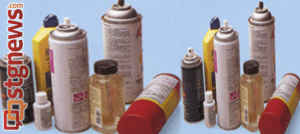
FEATURE – The Cedar City Police Department has reported the arrests of six juveniles, ages 13-17, over the past month for using computer dust remover as an inhalant.
Additionally, on Oct. 22, Tyson Glore, 33, of St. George, was allegedly huffing from a can of “Dust Off” when he drove over the south curb of St. George Boulevard and collided head-on into a vehicle driven by a woman with two children in the car. No injuries were reported.
Is inhalant abuse a problem in Washington County?
According to the Alliance for Consumer Education, there are 2.6 million juveniles that abuse inhalants each year in the U.S. Inhalants rank No. 4 on the list of most abused substances behind alcohol, tobacco and marijuana.
The National Institute on Drug Abuse reports that inhalants are abused more by younger teens and adolescents than by older teens.
In spite of these recent local reports, there has not been a significant increase in cases involving inhalant abuse in the City of St. George, St. George Police Sgt. Sam Despain said.
Although inhalant abuse is not limited to a specific age group, young adults are more vulnerable since there are no age restrictions in purchasing these products, Washington City Police spokesman Ed Kantor said. He personally recalled three to four cases of inhalant abuse reported in the past year in Washington City.
Most of these incidents are dealt with through the school resource officers, Washington County Sheriff’s Detective Nate Abbott said.
What are inhalants?
According to the National Institute on Drug Abuse, inhalants include a variety of substances such as solvents, aerosols, gases and nitrites that are rarely taken by any other method of administration.
The Alliance for Consumer Education reports that there are over 1,400 substances which are potentially dangerous when inhaled. Some common Inhalants can include computer dust remover, glue, felt–tipped markers, gasoline, butane, paint and cooking spray. These are all common household items that may be found in your garage, kitchen or at the local grocery store.
Washington County law enforcement officers agree that computer dust remover is the most common substance they see abused, largely since it is readily available and leaves no residue.
How are inhalants abused?
Abusers inhale these substances either through their mouth or nose. This is commonly referred to as “huffing.” They may snort or breathe the fumes from a container, dispenser, soaked rag or spray an aerosol directly into their mouth or nose.
Some abusers may breathe the fumes from a plastic or paper bag, a method referred to as “bagging.” This method can be most dangerous since the bag is placed over the head and it can lead to suffocation.
What are the signs and symptoms of abuse?
Things to look for include an over abundance of dust remover containers, cigarette lighters or markers in a teen’s room, car or backpack. Seeing a teen’s fingernails painted with white out or markers or finding paint on their face, fingers and clothing, can all be signs of abuse.
Symptoms of abuse are similar to those of other substances such as alcohol, including slurred speech, behavioral changes and perhaps a change in friendships, Kantor said.
Dangers and Health Effects
Short-term effects of inhalant abuse can include headaches, severe mood swings, tingling in hands and feet, nausea, hearing loss and violent behavior.
Long-term effects of abuse may include damage to the nervous system, liver and kidney; hearing loss; or bone marrow damage. Inhalants can also cause permanent brain damage by cutting off oxygen flow to the brain.
Prevention and treatment
If you suspect your child or someone you know is abusing inhalants confront them and encourage them to seek professional counseling. There are many great sources of information on the internet where parents can educate themselves about inhalant abuse and seek assistance.
Washington County law enforcement agencies recommend that parents educate their children on the dangers of abusing inhalants and encourage them to report any abuses they see.
“Developing good relationships with your kids and providing education on the dangers involved with inhalants can play a big part in preventing these problems,” Abbott said.
If you would like to report inhalant abuse, contact your local law enforcement agency.
Resources
- Inhalant Abuse Prevention
- Inhalent-Abuse.Org
- Utah Department of Human Services
- National Institute on Drug Abuse
Related posts
- Man causes head on collision after huffing cleaning product
- Impaired driver hits brick wall, sustains minor injuries
Email: [email protected]
Twitter: @STGnews
Copyright St. George News, SaintGeorgeUtah.com LLC, 2013, all rights reserved.

i wonder if kids get these ideas of the internet? hmm